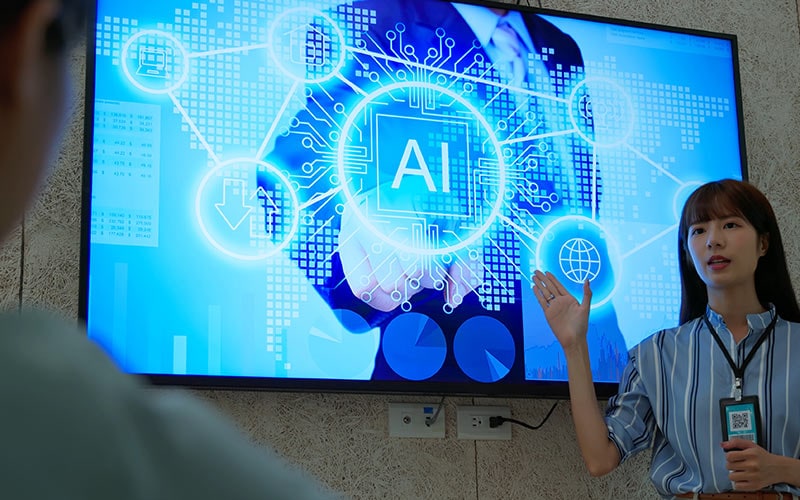Insights
- Companies must shift to a product-centric operating model, where customer experience is paramount.
- But this isn’t easy to do. A change management program is vital to build new skills and teams.
- Redefine SME culture, encourage interdisciplinary collaboration, align goals, embrace automation, and adopt a platform mindset to compete ahead.
Always-on digital business implies technology is the primary, and often only, interface for customers to interact. Each interaction should be flawless from the start, leaving no room for errors.
Companies must shift to a product-centric approach, where customer experience is of utmost importance. They should reimagine customer journeys and organize integrated product teams around value streams to improve efficiency through waste elimination. It requires a data-first live engineering mindset to scale Agile and DevOps across distributed cloud landscapes. When done well, organizational rhythm amplifies and value creation fastens.
Firms use Agile to build digital, cloud, and AI workstreams, but outcomes are not always meaningful. Product-centric value delivery helps businesses achieve value faster and do course corrections when required.
Product-centricity is less about products and more about delivering value through client experience, customer journey, and value streams. For example, concentrating on customer journeys unites business and IT teams in an autonomous product team construct. Such integrated teams are “true Dev and Ops teams that take end-to-end ownership through the product life cycle.”
Product-centricity is less about products and more about delivering value at every stage of the customer journey
But product-centricity isn’t easy. Legacy transformation is hard, and finding digital-savvy, lean product release talent is even harder.
Where it all started
Most large enterprises adopted the functional model, inspired by the assembly line's success in the last century. Specialists completed tasks and handed them to the next team in the flow. As technology emerged, IT similarly comprised specialized units for enterprise software development.
During this era, specialists collaborated to improve technology, designs, patterns, and processes within their specialization. Teams from business, sales, marketing, support, and logistics, bridged the gap between technology and customers. That meant inputs from across teams, and not just IT output, shaped customer experience.
However, today’s customers directly interact with enterprise software developed by IT teams, making software and product experience an integral part of the brand experience.
IT has evolved into business and operations teams too. Business handles software requirements, IT manages implementation, and operations assist employees and customers to use technology systems efficiently.

Each team has evolved further into specialized groups – business and operations teams based on processes or regions, and IT teams based on capabilities and technology. Because systems often reflect the organization’s communication structure (as per Conway’s Law), customer-centricity is lacking, if there at all.
Firms that prioritize customer journeys in their systems, platforms, and organizational structures fully embrace customer-centricity and benefit from fast-paced release cycles and product experimentation.
This future operating model, with both a product and platform focus, is inherent in this journey. Companies break down organizational silos and think about customers across digital capabilities, talent, and governance. Agility, speed, and innovation become integral, not mere afterthoughts.
Product-centricity means a new approach to ways of working
This Infosys paper covers the benefits and challenges of product-centricity. Now we talk about the change management program to build new skills and teams for a product-centric operating model. We look at these attributes through six lenses, including subject matter expert (SME) culture, adaptive feedback, and platform mindset (Figure 1).
Figure 1. Team characteristics for a digital operating model
Source: Infosys
Strong SME culture
Organizations follow a good SME culture, but SMEs end up in silos and only focus on their expertise without acknowledging overlapping concerns. IT organizations have evolved into specialized tech capability centers covering UI, backend services, infrastructure, data, etc., with SMEs to match. Business-IT-operations firms are siloed based on vertical processes such as new business, fulfillment, and servicing.
In the product-centric operating model, SMEs need broader tech knowledge, full-stack engineering, and product owner skills to grasp the impact of their actions across the business.
Interdisciplinary engagement
A visionary product organization integrates disciplines across technology, customer experience, market insights, and budgeting. Such firms benefit from individuals who communicate across disciplines, understand others’ motivations and objectives, and leverage collective expertise to make the sum of parts greater than the whole.
Our Agile Radar research confirms that a common purpose and shared vision, with mature Agile levers like upskilling and self-organized teams, enhances business value.
A technologist must fully understand the business domain to grasp requirements and technology's context of use. Likewise, a UX person should know technology constraints to enhance software features without over-complicating designs. A functional domain specialist should possess the expertise to understand human and technological aspects while envisioning requirements.
Teams that understand each other's language and motivations enrich each other and identify the gaps early on. SMEs should become SMIs (subject matter informed) in other areas to connect with experts across the business.
SMEs should become SMIs in other areas to connect with experts across the business
Cross-organization communication creates a unified and customer-centric team objective, moving away from siloed objectives. Firms should define career streams that encourage interdisciplinary engagement and cross-skilling (with adequate safety nets and incentives to build trust while venturing in new areas), even while encouraging specialization.
Unified, outcome-driven teams
Successful product-centric teams align on business outcomes such as user feature adoption, productivity improvement, and customer experience enhancement. The best teams swiftly address impediments and collaborate to solve problems. They focus on finding the what, why, and how of solution development, improving the product, and raising the bar for unified outcome goals. This differs from functional organizations, where hierarchy can hinder the recognition of ideas and solutions from junior team members.
Cross-skilled team members with the right incentives and career streams achieve innovative problem solving and unified outcome metrics. OKRs (objectives and key results) are helpful here – connecting build-measure-learn components of the product life cycle.
Adaptive feedback
With the move to customer-centricity, product-centric teams must respond to market signals and adapt products accordingly. This ability to listen must be baked into the products (via observability and telemetry), or through automated data collection; analysis and insights generations; and time motion studies. The Starbucks mobile app, for example, remembers customers’ preferred stores and payment methods, enables rapid reorders of favorite items, locates the nearest store through graph analytics, estimates the wait time, and shows where to pick up orders inside the store. Such data analysis within the customer journey (buying a cup of coffee) creates consistency and quality through standard protocols for preparing menu items.
This responsiveness based on insights, metrics, and telemetry is called sentience. The product team’s ability to respond quickly to problems brings the dynamism of a startup.
To achieve dynamism, product-centric teams should include customer engagement analysts and operations analysts, which brings insights from around the business. Siloed organizations lack this level of listening and adapting (or “sentience”) due to more confrontation than collaboration, and more hierarchy than problem solving. A person from an old manufacturing giant said in this Harvard Business Review article: “If you can’t resolve an issue, you go to the plant manager. But we don’t like to bother him often with small matters. We should be able to settle them ourselves. This trouble is we don’t. So [the initiative] dies.”

Automation-first
Enterprise IT systems should make changes without any disruption. IT teams need appropriate regression test automation and monitoring tools to fix the problems. Automation is paramount in the product-centric operating model.
Analytics, automation, and telemetry play key roles in an automation-first approach at every stage of the software development life cycle, whether coding, design, testing, data creation, or monitoring. Teams should upskill in automation and advanced software engineering, and gain a good understanding of DevSecOps tooling, to adapt and run faster.
Platform mindset
A project-oriented, traditional approach to product development builds around known use cases, stakeholders, and business environments.
A product-centric approach requires a platform mindset, where use cases and stakeholders and ecosystem players change and evolve.
A product-centric approach requires a platform mindset, one where team dynamics continuously change and evolve
But old habits die hard, even in high-performing product-based teams. Key players must embrace the concepts of platform mindset and continuous change.
Evolution is vital for an organization’s survival, including IT systems. They must adhere to principles of configurability, extensibility, interoperability, and swappability. Teams must conduct tree-of-thought simulations and premortems to anticipate system changes in case of altered base case assumptions or business scenarios.
To enable this, product-centric teams must develop a platform-oriented mindset, test decisions against evolvability principles, and factor in business metrics such as scale, adoption, operational efficiency, and user experience.
Bringing it all together
Product-centricity is the future operating model. Firms that get their digital transformation right will:
- Embody the agility of a startup.
- Respond to customer needs.
- Thrive in a networked, connected environment.
- Maintain velocity of ideas and innovations.
- Find competitive advantage through platforms.
Digital leaders such as Starbucks, Netflix, and Haier embed these levers in their operations, and their success stories speak volumes.
Firms should build a cross-disciplinary pool of talent on priority. Here, product-centric value delivery is not only rooted in technology adoption, but also in organizational structures and career stream management. Enterprises must break down old silos and incentivize team members to move to this way of working.
Get it right, and product-centricity becomes an accelerator. Teams unite around a customer-centric objective and optimize value flow. Businesses then create superior products and services and deliver customer-centric services. They rise as live enterprises.






